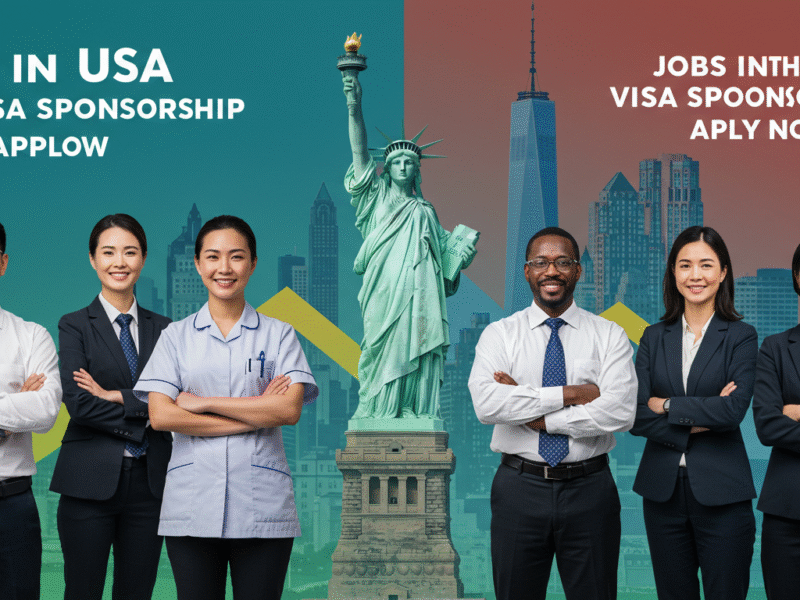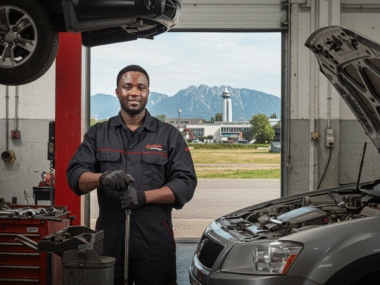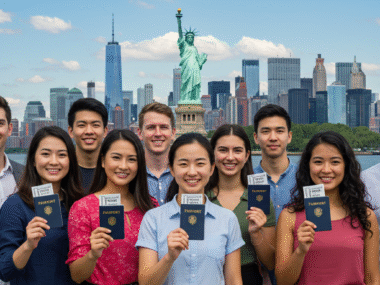Imagine landing your dream job in the heart of America, where innovation meets opportunity, and your skills could propel you into a thriving career—all while getting full support to make the move across borders.
Working in the USA has always been a magnet for talented people worldwide, and 2025 is shaping up to be an exciting year for jobs in USA with visa sponsorship. If you’re sitting in another country dreaming about the bustling streets of New York, the tech hubs of Silicon Valley, or the sunny beaches of Florida, you’re not alone. Thousands of international professionals are eyeing these opportunities, and the good news is that many American companies are eager to sponsor visas for the right candidates. Whether you’re a software engineer, a nurse, or a teacher, there’s a path waiting for you. In this guide, we’ll walk through everything you need to know about finding and applying for these roles, from the basics of visa sponsorship to tips that could land you an interview tomorrow. Let’s dive in and turn that dream into a plan.
Understanding Visa Sponsorship: Your Ticket to Working in the USA
First things first—what exactly does “visa sponsorship” mean? It’s when a U.S. employer steps up and agrees to support your work visa application. This isn’t just a nice gesture; it’s a legal process where the company petitions the government on your behalf, showing that you’re essential for the job and that no qualified American worker is available. Without sponsorship, getting a work visa can be tough, but with it, doors swing wide open.
In 2025, visa sponsorship jobs in USA are more accessible than ever, thanks to a recovering economy and labor shortages in key sectors. Employers know that global talent brings fresh ideas and skills, so they’re willing to invest in the process. But it’s not free for them—they cover filing fees, legal costs, and sometimes even relocation help. For you, it means a stable job, competitive pay, and a chance to build a life in one of the world’s most dynamic countries.
Why is this booming now? Well, post-pandemic shifts have created gaps in the workforce. Industries like tech and healthcare are desperate for skilled workers, and the government has streamlined some processes to fill them. For instance, the H-1B visa cap for fiscal year 2026 (which starts applications in 2025) saw over 118,000 selections in the initial lottery, showing high demand. If you’re qualified, your odds are better than you think.
The Main Types of Work Visas You Can Get Sponsored For
Not all visas are created equal, so let’s break down the most common ones for jobs in USA with visa sponsorship 2025. The U.S. Citizenship and Immigration Services (USCIS) oversees these, and each has its own rules.
Starting with the H-1B visa— this is the superstar for specialty occupations like IT, engineering, and finance. You need at least a bachelor’s degree or equivalent experience. Employers file a petition, and if approved, you can work for up to three years, extendable to six. In 2025, top H-1B sponsors include tech giants, with over 7,000 approvals for one major company alone. It’s competitive, but if you’re in a high-demand field, it’s worth pursuing.
Then there’s the EB-3 visa for skilled, professional, or unskilled workers. This one leads to a green card, meaning permanent residency. It’s great for roles in manufacturing, hospitality, or healthcare aides. Companies sponsor you through a labor certification process to prove the job can’t be filled locally. In 2025, openings in food service and warehousing are hot due to labor shortages.
For temporary seasonal work, check out H-2B visas. These are for non-agricultural jobs like landscaping or tourism, lasting up to a year. The Department of Labor lists re-advertised positions online, making it easy to spot sponsors.
Don’t forget L-1 visas for intracompany transfers—if you work for a multinational company abroad, your employer can transfer you to their U.S. branch. And for extraordinary talents, O-1 visas cover artists, scientists, or athletes.
Students on F-1 visas can use Optional Practical Training (OPT) for up to a year post-graduation, often leading to H-1B sponsorship. Exchange visitors on J-1 might get waivers for sponsorship too.
Eligibility boils down to your skills matching the job, and the employer proving need. Processes involve petitions to USCIS, then visa applications at U.S. embassies. In 2025, expect faster processing for premium filings, but always check for updates since rules can shift.
Hot Industries Offering Visa Sponsorship Jobs in 2025
The USA’s job market is diverse, but some industries are leading the charge in visa sponsorships for 2025. These sectors have massive shortages and are actively seeking international talent.
Tech tops the list. Software developers, data scientists, and AI experts are in high demand. With the rise of remote work and digital transformation, companies need global minds. In May 2025, job postings for tech roles with sponsorship spiked, especially in California and Texas. Salaries can hit $100,000+, and sponsors like Amazon and Google file thousands of petitions yearly.
Healthcare is another powerhouse. Nurses, physicians, and therapists are critically needed due to an aging population. Registered nurses rank high for sponsorship likelihood, with roles offering $70,000+ starting pay. Post-pandemic, medical fields saw a 3.2% sponsorship rate in physician postings. If you’re a doctor or nurse, look into EB-3 or H-1B paths.
Engineering and manufacturing follow closely. Civil, mechanical, and electrical engineers find sponsors in construction and auto industries. With infrastructure bills pumping billions into projects, jobs are plentiful.
Education and research are growing too. Teachers, especially in STEM, and researchers at universities like Stanford offer sponsorships. Over 90 research positions at one top university in 2025 come with visa help and $50,000+ salaries.
Hospitality and food service round it out for unskilled roles. Waiters, cooks, and hotel staff get H-2B sponsorships, paying $7.25 to $15.50 hourly. Construction and agriculture also sponsor for laborers, with EB-3 green cards possible.
Other niches? Marketing specialists, accountants, and even plumbers see opportunities, with salaries from $50,000 up. The key is matching your skills to these booming areas.
Top Companies Sponsoring Visas in the USA for 2025
Who are the big players? Based on recent data, several companies dominate H-1B and other sponsorships.
Amazon leads with over 7,000 H-1B approvals in early 2025, focusing on software engineers and logistics roles. They sponsor for warehouses, tech, and operations.
Google (Alphabet) follows, with thousands of visas for developers and analysts. Their global reach makes them sponsorship-friendly.
Microsoft, Meta (Facebook), and Apple are tech heavyweights, sponsoring for AI, cybersecurity, and hardware positions. Microsoft alone has over 68,000 total sponsorships historically.
In consulting, Infosys, Cognizant, and Deloitte file massive petitions—Infosys tops lists with Bengaluru roots but U.S. focus.
Healthcare giants like CHRISTUS Health sponsor psychiatrists and therapists. Johnson & Johnson and ExxonMobil offer roles in pharma and energy.
For EB-3, companies in food service, warehousing, and manufacturing sponsor unskilled jobs. Walmart, Bank of America, and Intel also make the list.
Smaller firms and startups sponsor too, especially in niches like biotech or renewable energy. Check USCIS’s H-1B Employer Data Hub for the latest.
Where to Find Jobs in USA with Visa Sponsorship 2025
Hunting for these jobs? Start smart.
Job boards are goldmines. Indeed has 266 visa sponsorship listings, from teachers to oncologists. LinkedIn boasts 37,000+. Glassdoor shows 12,273.
Specialized sites like MyVisaJobs track sponsors and salaries. USponsorMe focuses on foreigners. VisaSponsor.Jobs lists verified global openings.
Government sites: SeasonalJobs.dol.gov for H-2B. USCIS for employer data.
On X (formerly Twitter), posts highlight roles like line cooks or nurses with sponsorship. Follow accounts like @WorkVisaJobsUSA for updates.
Network on LinkedIn—connect with recruiters. Attend virtual fairs or use agencies specializing in international placements.
Set alerts for “visa sponsorship jobs USA 2025” to stay ahead.
Step-by-Step Guide to Applying for These Jobs
Ready to apply? Here’s how.
- Tailor Your Resume: Use U.S. format—concise, with keywords like “H-1B eligible.” Highlight international experience.
- Craft a Cover Letter: Explain why you’re a fit and mention visa needs subtly. “I’m excited to bring my skills to the U.S. and am open to sponsorship.”
- Search and Apply: Use boards mentioned. Apply directly on company sites for better odds.
- Prepare for Interviews: Expect questions on sponsorship. Practice: “I have the qualifications for H-1B and can start once approved.”
- Employer Petition: If hired, they file Form I-129 for H-1B. Costs $460+, but they pay.
- Visa Application: After approval, apply at embassy with DS-160 form.
- Relocation: Many offer help with moving, housing.
In 2025, apply early—H-1B lottery opens March. Track status online.
Key Requirements and Qualifications You Need
To qualify, you typically need:
- A degree or equivalent in the field.
- Relevant experience—2+ years for most.
- English proficiency (TOEFL/IELTS if needed).
- Clean background check.
For H-1B, specialty occupation proof. EB-3 requires labor certification.
Skills like coding, patient care, or project management boost chances. Certifications (e.g., RN license for nurses) are crucial.
No degree? Unskilled EB-3 or H-2B paths exist for delivery drivers or caregivers.
Pro Tips to Boost Your Chances of Getting Sponsored
- Build a U.S. network: Join groups on LinkedIn.
- Get certified: U.S.-recognized quals help.
- Be flexible: Consider smaller cities for less competition.
- Pitch value: Show how you solve their problems.
- Avoid red flags: Don’t mention sponsorship too early.
- Use recruiters: They know sponsors.
Success rate? About 30% for H-1B lottery, but targeted applications improve it.
Common Challenges and How to Overcome Them
Visa denials happen—overcome with strong petitions.
Costs: Employers cover most, but budget for travel.
Cultural adjustment: Join expat communities.
Delays: Apply early; premium processing speeds it.
Competition: Stand out with unique skills.
Family: Some visas allow dependents.
Real-Life Success Stories from 2025 Applicants
Take Maria, a nurse from the Philippines. She found an EB-3 sponsor on Indeed, got her green card, and now earns $80,000 in Texas. “It was worth the wait,” she says.
Or Raj, an Indian developer sponsored by Microsoft via LinkedIn. His H-1B led to a green card path.
These stories show persistence pays.
What to Expect in 2025: Trends and Outlook
2025 looks bright—tech and healthcare will dominate, with AI roles surging. EB-3 for unskilled jobs grows due to shortages. Possible policy changes could ease processes.
Salaries? Tech: $120,000 average; healthcare: $90,000.
Remote options might increase, but most require on-site.
Wrapping Up: Your Next Steps to Apply Now
Jobs in USA with visa sponsorship 2025 are calling—don’t wait. Update your resume, scout boards, and reach out. With the right prep, you could be packing soon.
For official info, visit the USCIS website here.
Or start searching on MyVisaJobs here. Good luck—you’ve got this!











